Cheers! – Kuba Ceremonial Wine Cups
PRIMITIVE - Monday, March 07, 2016By Misaki Imagawa
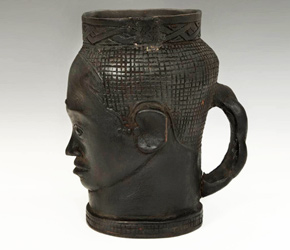 |
|
"Ladies and Gentlemen, may I have your attention please? I would like to propose a toast…"
And so begins an all too familiar ceremony that has been going on for thousands of years – a ceremony just about always involving alcohol. The Ancient Greeks once proclaimed that drinking wine was a defining characteristic of their great Hellenistic culture, and those who did not were considered barbarians. Perhaps they would have been surprised to know that alcohol consumption was a widespread practice in many ancient and much older civilizations from countries in the Far East to the tribes and early empires of the Americas. Alcohol was ritually consumed to seal pledges, prepare for battles, celebrate victories, honor gods and spirits, and commemorate important ceremonies such as births, marriages and funerals. Today, alcohol is still used ceremonially the same way, but add a good cup to the ceremony and everything becomes magnified.
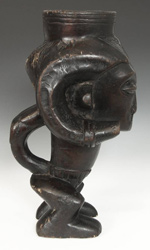 |
|
In many areas of Africa, palm wine played a central role during ceremonies. Palm wine is an alcoholic beverage made from the sap of palm trees. The Kuba people from today’s Democratic Republic of Congo in Central Africa, particularly value palm wine and special cups meant to hold the beverage. One Kuba proverb, states: "Man is like palm wine – sweet youth lacks wisdom and old age lacks sweetness of character." It describes the fleeting sweetness of the drink, which quickly becomes sour acidic vinegar if left to ferment for longer than a day. In the Kuba Kingdom, which flourished from the 17th through 19th centuries, the distribution of wine was considered a gracious act of hospitality and intricately carved cups called Mbwoongntey, were prestige objects and works of art meant to contain the drink.
Kuba art is renowned for their use of rhythmic geometric patterns that decorate all sorts of ritual objects, masks, textiles and these highly collectible ceremonial cups. The Kuba have been described as a people who cannot bear to leave a surface unadorned. It stems from a tradition that associates elaborate ornamentation with high status and prestige. You might say, to the Kuba people, more equals more. In the Kuba Kingdom, titles were not hereditary but awarded on a merit-based system that promoted loyalty to the king. One way in which the tribal aristocracy demonstrated their goodwill and generous hospitality was by offering palm wine to guests and fellow titleholders. The host would present a carved wooden cup to be admired by the guests before communal wine consumption.
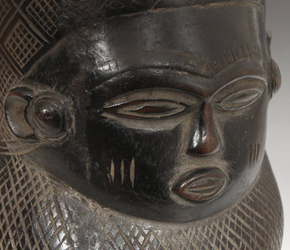 |
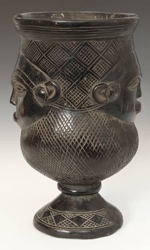 |
|
Like other examples of Kuba prestige objects, details adorning the cups reflected the owner's wealth, status and influence within the kingdom. Similar to Kuba textile patterns, Mbwoongntey designs are at times lively and spontaneous and at other times systematic and orderly. Etchings around the rim of the cup represented the traditional hairstyles of nobles, exposing the forehead to emphasize its importance as the center of wisdom and rationality. Serene facial expressions and a small, closed mouth also symbolized the value of contemplation before speech. Features that most boldly communicated a significant level of importance to the owner were animal horns, such as the buffalo's, which represented power and vitality. Likewise, ram horns were only permitted to be commissioned by a person who held a senior position in court. Carved by special request to the master craftsmen of the kingdom, every cup is a visual display of the ideals and refinement dear to Kuba nobility, titleholders and the king.
The artistic expression of the Kuba people knows no bounds, inspired by the numerous, diverse ethnic groups that made up the kingdom. Some of the finest African art comes from the Kuba people in Central Africa, whose heritage places great value on the meticulous detail given to their decorative artworks. So put down your crystal glassware and raise your Mbwoongntey as we propose a toast – to prestige!
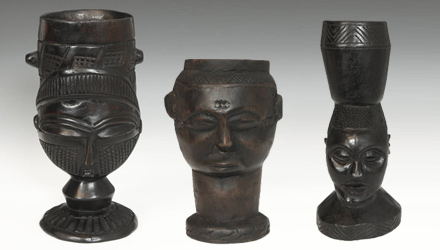 |
Download this Article: Cheers - Kuba Ceremonial Wine Cups.pdf